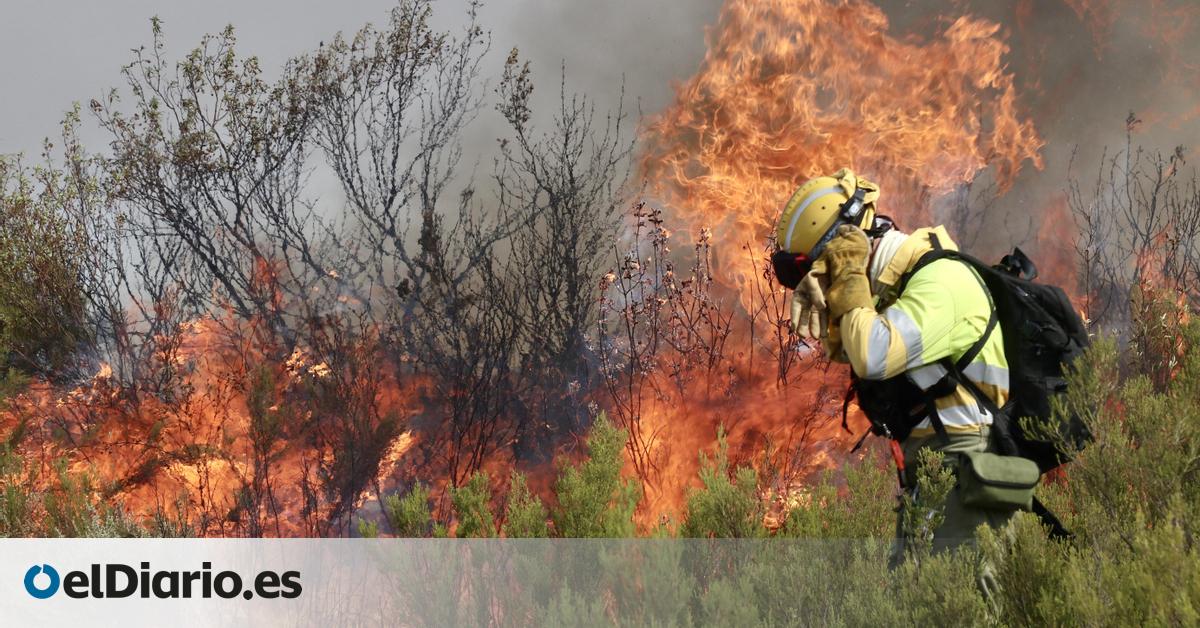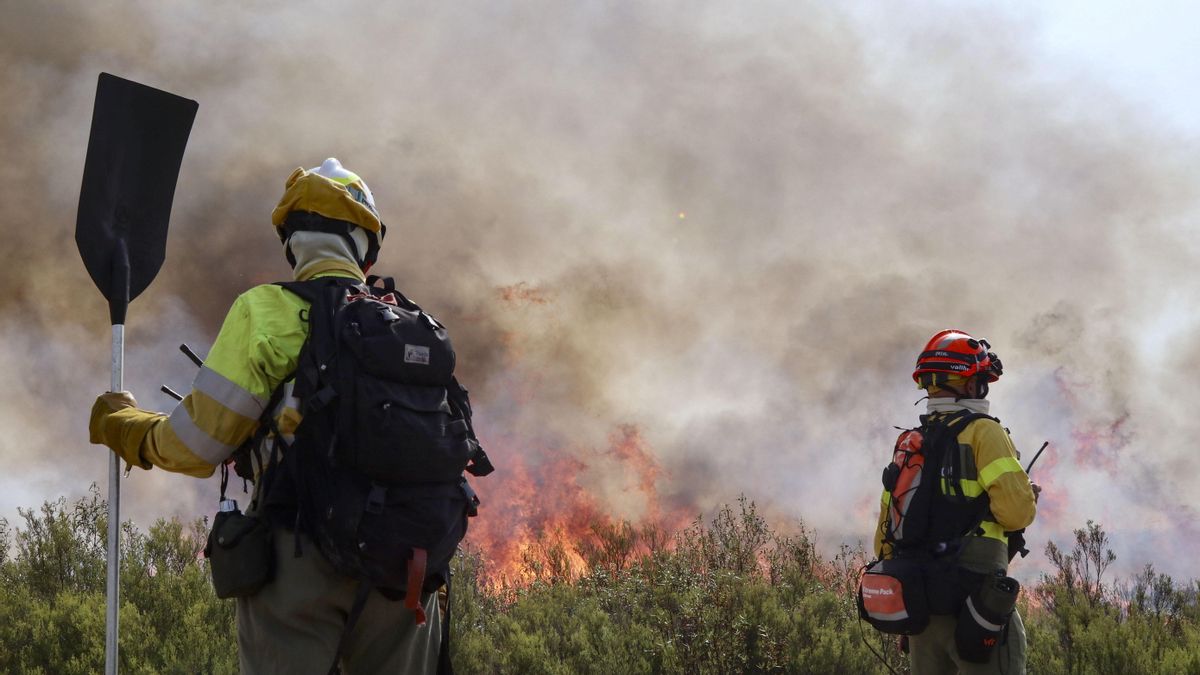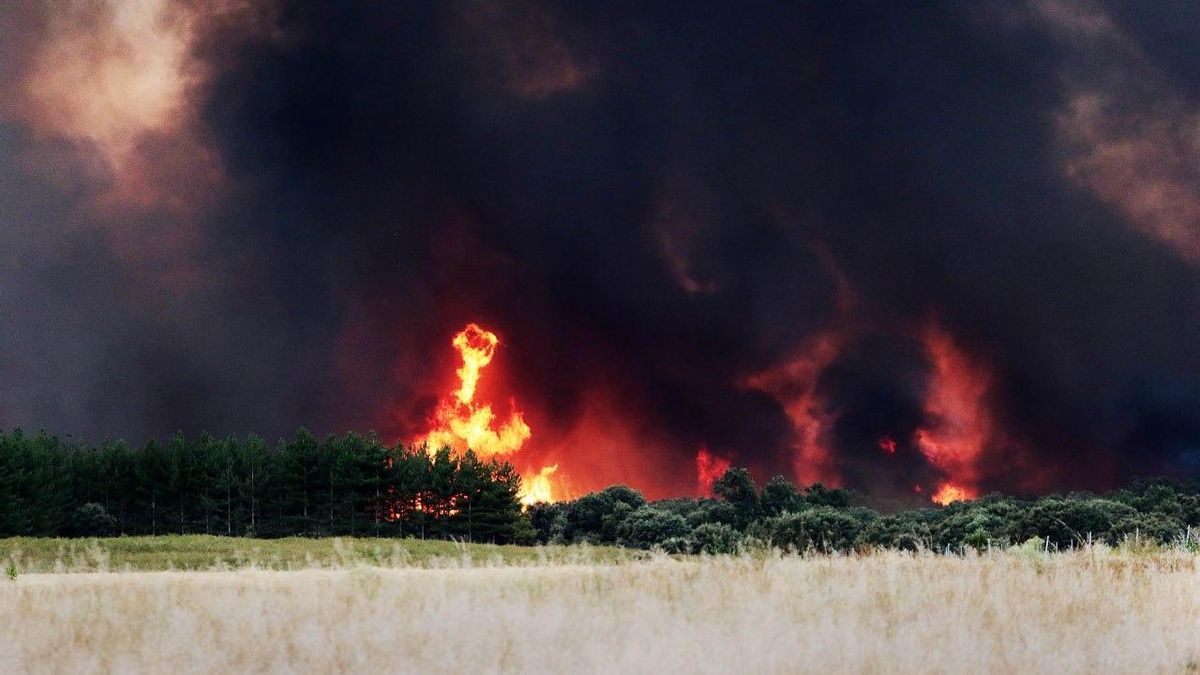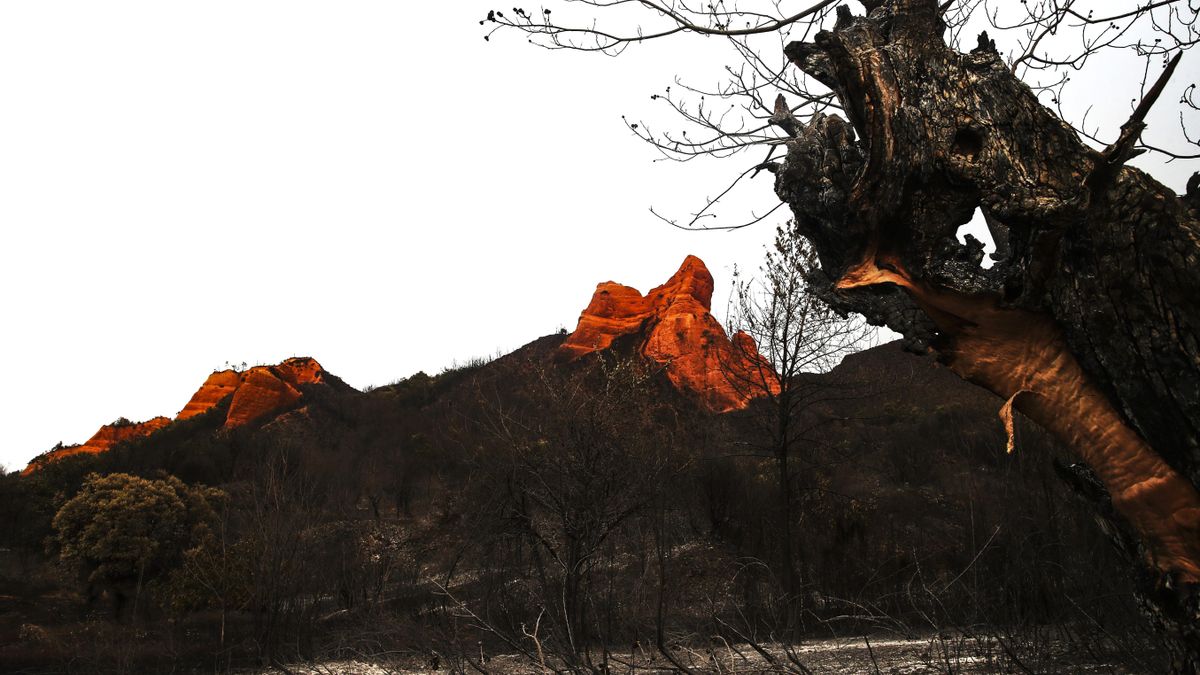
Castilla y León lives the worst wave of fire that is remembered. He is a recurring holder, but that occurs more and more frequently. If in 2022 more than 95,000 hectares were burned and four deaths had to be regretted, three years later, in 2025, there has been a wave that has led to having a fortnight of large active simultaneous fires in more than half of the provinces of the community and that has already charged its first deadly victim, a volunteer who fought against the fire. Meanwhile, forest firefighters spin, sleep a few hours and face temperatures that the community had never lived. After the large fires recorded in Ávila at the beginning of the heat wave, the worst is now lived in León and Zamora and the operation is absolutely overflowing, according to firefighters who work in the brigades of the Junta de Castilla y León.
“There is no supply, there are not enough crews for so many fires,” says a Leon firefighter with years of experience in the fight against fire. “For a partner of a night gang yesterday and today they were his rest days. Yesterday he came home at 7 in the afternoon and today he got up and has marched with the uniform to help his teammates voluntarily,” he says. “The classmates are bitter because they say ‘I’m killing myself’. They are days of 15 or 16 hours, sleeping five hours and returning again,” he says with concern.
The wear is dragged from the great fires unleashed in Ávila last week. The media scarcity forced to mobilize support crews from the province of León. It happened on Saturday, when media from León were deployed in Ávila just when fire hell was unleashed in the Leon province that still continues. With four hours of road travel and after a workday of eleven hours, on the way back their province wrapped in flames were found. A 10 -hour break, at best, and have to turn off fires.
“Everyone is having incredible workloads, hopefully being superhombres and being able to be 24 hours in a fire, but it is not so,” he laments.
The risk is multiplied: “The operation is overwhelmed and exhausted”
In Castilla y León, the one that affects 500 hectares is considered a great fire: these fires have overlap that they have at least that extension, according to the approximate data of Copernicus. In just four days almost 23,000 hectares have been burned – according to the European satellite Copernicus -, with open flanks in León – dusted by fires that have affected Las Médulas and near the Valley of Silence -, Zamora – Puercas -, Palencia – in the Palencia Mountain -, Salamanca – Cerca de Ciudad Rodrigo – and Ávila – in the surroundings of Las Navas del Marqués.
“The operation is very tired. There are many fires and there are no relays. There are people resting 6 or 7 hours and working the other 16 hours. One partner the other day he told me that he was working 22 hours in a fire,” reproaches the president of the Union of Environmental Agents of Castilla y León, Esaú School.
“The operation is overwhelmed and exhausted,” explains a spokesman for the Association of Forest Workers of Castilla y León. “The organization of the operation is a disaster,” he reiterates school, a comment subscribed [el martes] There were in Cabrera flames – a fire at a higher level of risk – only a bulldozer and a truck. ”
The accumulation of gravity fires with such tight operations has caused unusual situations, as neighbors going to rescue a group of brigades in the mountain in the abuse of helicopters and cars. It happened in the region of La Valdería this Monday, when the fire that from Zamora arrived in León was complicated. “The brigadistas are already used to that many things can happen, but they should not happen to us,” he summarizes. “We have a 16 -hour course and with that we are going,” says a member of the extinction teams to regret the lack of more training.

Before the death of the León volunteer, one of the minor injured in the Yeres Fire that has devastated the world heritage of the medulla was a brigadist who was involved in a fireball and that thanks to the team had no major consequences. In the same fire another singular circumstance was given: two brigades were trapped for two and a half hours on the mountain surrounded by the flames while the fire ran out of control towards the town of Carucedo. That is why he took to intervene in the area. “The town of the town complained that there were no brigadistas when the people began to burn, but the reality is that they could not get out of the fire,” explains the same firefighter. The town could only be saved thanks to the intervention of urgent displaced brigades from other points to quell the flames.
“Thank God we take experience with fires and learn, but the situation has to change: we must increase the means so that prevention work can be done in winter,” he says. “We need greater professionalization, training and, above all, prevention,” he explains.
A model -based model
The model of fighting fire in Castilla y León has not changed in decades. A part of the operation, the minor by far, is made up of public workers. However, the majority of extinction workers are paying companies, which are responsible for the land brigades (‘Romeo’) and the helitransported. The conditions of these brigades are more precarious. “We have what the Minister of Environment calls ‘flexible operation’: that is, the minimum of the minimum and wait for it to rain. The operation has collapsed and are improvising,” criticizes Sara Mateos, of CSIF.
After the serious fires of the beginning of the 2020s, in Losacio (where four people died), Sierra de la Culebra (Zamora), Sierra de France (Salamanca) and La Paramera, in Ávila, Castilla y León He promised to expand the duration of public workers’ contracts for brigades to work 12 months of the year. However, the unions reproach that, in the day to day, the changes have barely noticed.

The workers of the sector insist on the need for an operation that is 100% throughout the year, because Castilla y León has enough forest mass to give prevention work during winter and extinction during the summer. “We demand that the model be rethink because this will go to more. We want more places for public workers and that the private part is not a kingdom of Taifas. In addition, the sector agreement expired in 2024 and we do not know anything,” he adds a spokesman for the Autonomous Association of Forest Workers.
School, of the Union of Environmental Agents of Castilla y León, recognizes that there have been improvements in the material media, for example through the rent of a new fleet of vehicles, but regrets that the changes for the workers are, however, slow. “We are worse than in 2022,” he says. Sara Mateos criticizes that the regional government has not changed its vision on how to address fires. “They always blame others, but a bit of self -criticism is also necessary,” he concludes.
“There is no professional operation. Many brigades face a fire for the first time,” he says school, which points out that, in many cases, such as such a bad paid job, the foreign staff has increased. “Some do not know Spanish and we teach you Spanish and extinguish fires at the same time,” adds the president of the Environmental Agents of Castilla y León.

Cameras that confuse
In the absence of brigades, in recent years, the Junta de Castilla y León has increased its commitment to surveillance cameras to alert possible lights of fires despite the criticisms they have received by unions and workers. First, some thermal cameras were installed that gave problems – they saw, for example, if there was a sheet of a very hot roof – and then other 360º vision cameras were tendered, which do not convince environmental agents either.
“They can confuse dust with smoke, and if a endowment is notified and then there is a real alert, efficient media use is not made. In this sector, 10 minutes are very important,” Sara Mateos protests. Este school reiterates that false alarms are frequent. The spokesman of the Autonomous Association of Forest Workers explains that the information given by the cameras with which people provide: “The knowledge of the land and winds that a surveillance position cannot be replaced with a camera cannot be compared. They are very necessary positions,” he claims.
According to sources consulted by eldiario.es, this Monday, with 15 active fires in León, there were only staff to monitor in seven of them because there were no means to do extinction work. “In the fires of Fasgar and Riofrío these days, the surveillance positions were empty,” concludes Mateos. “That the Junta de Castilla y León does not sell us smoke, which we swallow every day,” claims the spokesman for the Autonomous Association of Forest Workers.
Source: www.eldiario.es

